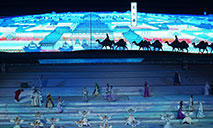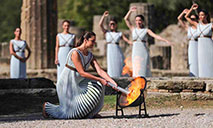The secret to Jingdezhen's pre-eminence in porcelain
NANCHANG, Oct. 21 (Xinhua) -- Jingdezhen, a small city in the mountains of east China's Jiangxi Province, has long been associated with the creation of quality ceramics.
Often called the "porcelain capital" for its important role in the domestic and international ceramic industry, Jingdezhen has been dedicated to the craft for over 1,800 years.
Due to its role as an official and royal kiln, it developed porcelain-making techniques that placed it in a league of its own.
Even today, a wide variety of porcelain products are still being exported to the world from Jingdezhen. Thousands of artists and lovers of ceramics visit here each year for a glimpse of the world's best china.
It currently boasts over 8,300 ceramic enterprises and more than 9,800 self-employed ceramic practitioners, while about 10 percent of its population is engaged in related businesses.
Here generations of ceramic artisans have enacted a profound interpretation of the spirit of craftsmanship: diligence, perfection, innovation. This is also the secret of the fine quality of the ceramics produced in Jingdezhen.
Just like the 72 transformations of Monkey King, a handful of clay cannot be transformed into a fine piece of Jingdezhen porcelain without going through a total of 72 procedures.
Experience and skill are essential. Hu Jiawang has a unique trick of "spitting." He judges the temperature in the kiln by the speed at which his spit evaporates from it, a method that is often more accurate than the thermometer.
And this is just the start. There are many more mysteries to be unpacked before one can fully understand the craft of the kiln.
"A piece of real art is created by the attitude of excellence, inner-peace, full-heartedness and precise skills," said Xiang Yuanhua, one inheritor of the imperial kiln techniques and methods.
Xiang's company, Jingdezhen Imperial Kiln Culture Development Co. Ltd., restores ancient styles of porcelain, some of which are displayed in the palace museums of Beijing and Taipei.
Among the 20,000 pieces produced by his company every year, only about 2,000 items make the grade. The fate of items that do not make the cut is brutal -- they are smashed and discarded, a long-preserved tradition in Jingdezhen.
Even with such high standards, Jingdezhen's collection of porcelain, preserved both above ground and underground, is second to none in the world.
"Jingdezhen's name didn't come from anyone but it is recognized by the world," said Xiang. "Jingdezhen porcelain has a strict standard and embodies the values of the Chinese people and Chinese aesthetics, and that has been passed down very well."
Potters in Jingdezhen never cease to innovate, while at the same time preserving traditions.
According to Yu Jihua, head of the Jingdezhen ceramic artists association, ceramic artists in Jingdezhen have always been very open-minded. "They're always willing to share their own experience and skills, which have been passed down over thousands of years, and accept new ideas."
There are some 30,000 non-local artists in Jingdezhen, of which about 5,000 are foreign artists. They are constantly injecting new blood and inspiration into the creation of Jingdezhen porcelain.
Su Hui, a recognized master of arts and crafts in Shaanxi Province, came to Jingdezhen two years ago for some new inspiration. "I've met many artists and friends over the past two years, and I feel that my creative ability has been greatly improved," he said.
"Jingdezhen is a city that is very tolerant of artistic creation, and porcelain making here is very mature in all respects. For young artists, they can start their dreams at a very low cost," added Su.
Among the foreign visitors is French artist Camille Kami. On her first visit to Jingdezhen, she marveled at this city "where an industry had been going on wholeheartedly for over a thousand years."
With such an illustrious history, such a wealth of talent and skills, and so much interest from new generations, the future of Jingdezhen seems secure. After thousands of years, the fire in the famous kiln is still burning bright.
Photos
Related Stories
- Live-action performance “china” debuts in Jingdezhen, Jiangxi
- Foreign potters mould dreams in China's porcelain capital
- Imperial kiln museum opens in China's porcelain capital
- Porcelain artifacts on plateau testament to integration of ethnic groups
- Young Chinese girls revive, innovate 1,200-year-old porcelain leaf cup making techniques
Copyright © 2021 People's Daily Online. All Rights Reserved.










